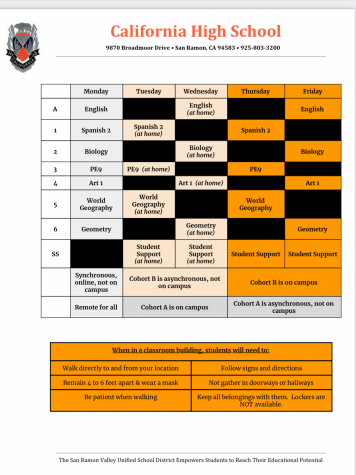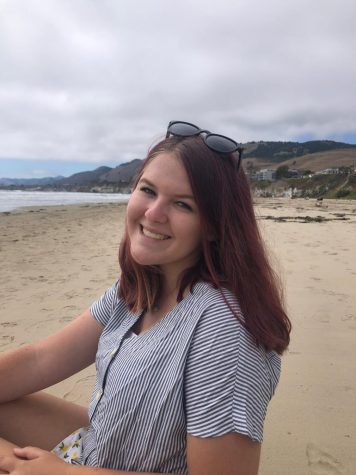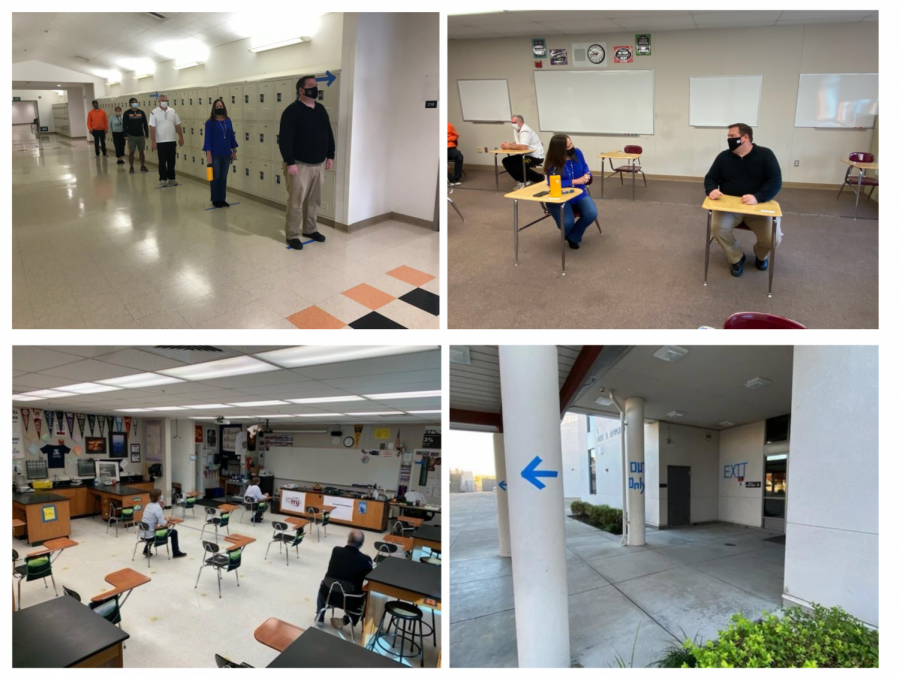District gives students choice to stay remote or switch to hybrid learning
A binding declaration must be submitted by Friday so schools can start preparing for a return to campus on Jan. 5
Photos courtesy of California High School
In a letter emailed to Cal High parents on Monday, Principal Megan Keefer included visuals of what a hybrid learning model would look like on campus.
We are currently conducting an anonymous survey for students and teachers alike to collect opinions on the reopening of Cal in the next semester. Click here to access the survey.
To go hybrid or to stay remote, this is the question students throughout the San Ramon Valley Unified School District are struggling to answer.
Parents were emailed information last Friday regarding the district’s hybrid plan along with this daunting question. With a week to submit a binding answer to participate in either full remote or in-person hybrid learning for the second semester, students are already starting to worry what to do during the middle of a global pandemic that’s only grown worse in recent weeks.
In an effort to calm students’ and parents’ safety concerns, and to plan a safe launch of the hybrid program on Jan. 5, schools will space desks at least four feet apart, students will be given or can bring individual materials to avoid sharing, and everyone on campus will be required to wear masks at all times. These guidelines plan to be strictly enforced and there will be harsh punishments for neglecting to do so.
“Truthfully, it’s going to be strict,” Superintendent Dr. John Malloy said during a Nov. 4 press conference with The Californian. “Health and safety is number one, but also your learning.”
The hybrid schedule will include two days of in-person learning and two days of asynchronous and independent work, according to a letter Principal Megan Keefer sent on Monday to Cal High to families. Mondays will remain a shortened remote day where students, both those on hybrid and remote plans, will meet with all of their classes for 30 minutes.

The second semester will include three cohorts. In-person hybrid learning will be split into A and B cohorts so only half the students need to be on campus at the same time. Cohort A students will be on campus Tuesdays and Wednesdays while B students will be doing asynchronous work independently from home. Cohort B students will then go to school on Thursdays and Fridays while A students will be working remotely. Students will not get to choose their hybrid cohort.
The C cohort will be for students who decide to stay remote and continue with synchronous online learning every school day. All classes for remote and hybrid students will be shortened five minutes to 75-minute blocks. The student support period is increasing five minutes to 40 minutes and moving to the end of the day.
Whatever choice students and their families make cannot be changed after their declarations are submitted by this Friday.
“I think it would be chaos trying to switch to hybrid because classes would change and it’d be really complicated,” junior Lewis Hare said.
Though specific courses will not change, students could see their teachers change. If a teacher is working on campus in a hybrid format but one of their students chooses remote learning, this student may be assigned a new teacher, Malloy said.
After spending nearly three months getting comfortable in their classes, some students are taking this into account and asking their teachers whether they will be going on-campus for school to help guide their own decisions.
“I really want to keep my teachers,” senior Ken Vejby said. “I want to play it safe.”
On top of getting used to teachers and their teaching methods, many students have gotten used to remote learning and aren’t sure that they want to flip to hybrid.
“[Remote learning] was hard at first, but right now everything is getting in the swing of things,” senior Keana Estorpe said.
On the other hand, many students have grown annoyed with having to learn through their computers all day with no social interactions beyond breakout rooms, and are ready for a change of pace. But the hybrid option will look very different from what students experienced last year before everyone was sent home and campuses closed in mid-March.
In the letter sent to parents, Keefer explains that students will be able to socialize but they will need to remain at least four feet apart and wear masks, inside and outside of classrooms. Group work in classrooms will be modified so students can maintain proper social distance. Students also cannot gather in groups in hallways, outside classrooms or anywhere outside on campus.
The letter also indicates that there will be plexiglass at the teacher desk for a barrier in case a student wants to have a one-on-one conference. Students should expect traditional instruction from in front of the classroom and possibly some video conferencing so teachers can also connect with students working at home, the letter states.
Despite these changes, some students are still choosing the hybrid plan because they aren’t able to focus in their homes during online school. Many have also found that they simply learn better in an in-person environment rather than through a computer.
“It’s hard being on a screen all day and getting headaches,” sophomore Kylie Matek said. “It can feel like the same thing over again.”
Added senior Katie Barlow, “I personally work better in a class. I hope students follow precautions so we can stay [on campus].”
Students who do not wear masks will be asked to. If they don’t they will be asked to leave campus and a parent meeting will determine the next steps to take, according to Keefer’s letter.
When it comes to making this important decision, the choice for some is very clear. Some students are taking into consideration what’s best for the people around them, including family members and loved ones who are at a higher risk to develop severe symptoms if they contract COVID-19.
“We don’t want to compromise anything for my family,” said Estorpe, who lives with her grandma and two younger siblings that she helps care for.
Students and their families will have to make this final decision with the information provided by the district and stay true to what they feel will work best for them. While this may not be easy to do, it must be done to ensure a consistent learning path for all and to give the district enough time to plan for the return to on-campus learning, Malloy said.
“This needs to boil down to, where are you today,” Malloy said. “Do you feel comfortable going back to school or not?”

Emmy Burrus is a senior at California High School, and is entering her third year of being a part of the Californian staff as Co Editor-in-Chief. Last...









